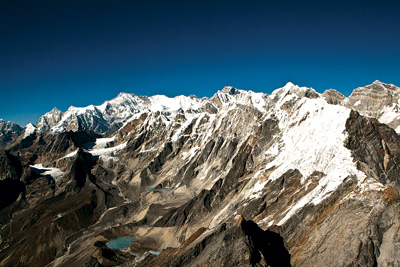It’s not the most immediate concern for Nepalese tourism yet, but global warming is already making its presence felt.
The majesty of the Himalayas: to breathe its crisp air and stare at its imposing jagged silhouette against an infinite clear blue sky is nothing short of awe-inspiring. Getting there, however, has never been easy. Even today, with airport access and availability of modern amenities, the Himalayas remain a relatively difficult region to reach and navigate, demanding a mix of determination and passion, and time and commitment.
For Nepal, mountain tourism has been a steadily growing and significant economic sector for over half a century. The mountains themselves have become the national mascot for all things climate change, except perhaps in the context of tourism itself. And so, just how might climate change affect mountain tourism in Nepal?
 While it is impossible to come up with a definite answer to that question, several possibilities can be outlined based on available scientific data. The issue of the melting glaciers and snowcaps are naturally the first things that might come to mind. While those will have devastating implications in Nepal and beyond, how could this have a direct effect specifically in people’s interest in visiting the region? Unlike mountain tourism in the west where snow is a pre-requisite for its ski-oriented attractions, tourists are drawn to Nepal’s mountains for its terrain, the adventure and the sheer size and scale of the Himalayas, as well as the culture of the region – with or without the snow.
While it is impossible to come up with a definite answer to that question, several possibilities can be outlined based on available scientific data. The issue of the melting glaciers and snowcaps are naturally the first things that might come to mind. While those will have devastating implications in Nepal and beyond, how could this have a direct effect specifically in people’s interest in visiting the region? Unlike mountain tourism in the west where snow is a pre-requisite for its ski-oriented attractions, tourists are drawn to Nepal’s mountains for its terrain, the adventure and the sheer size and scale of the Himalayas, as well as the culture of the region – with or without the snow.
 The decision to visit the region, however, could be tested more by flight delays that could grow more common and longer than they already are. A weeklong flight cancellation prompted by poor weather conditions in November 2011 created a massive international public relations disaster for Nepal’s tourism. It also created a logistical and financial nightmare for the tourists who had to reschedule their international flights and miss workdays–not the kind of ending one looks for in a vacation. Considering the regularity with which these delays take place every season it would naturally be wise for any tourist to keep at least a couple of days open between one’s visit to the Himalayas and the international flight back to their country of origin. Still, climate change induced growing extremities of weather will be no friend of tourism in Nepal in this particular context.
The decision to visit the region, however, could be tested more by flight delays that could grow more common and longer than they already are. A weeklong flight cancellation prompted by poor weather conditions in November 2011 created a massive international public relations disaster for Nepal’s tourism. It also created a logistical and financial nightmare for the tourists who had to reschedule their international flights and miss workdays–not the kind of ending one looks for in a vacation. Considering the regularity with which these delays take place every season it would naturally be wise for any tourist to keep at least a couple of days open between one’s visit to the Himalayas and the international flight back to their country of origin. Still, climate change induced growing extremities of weather will be no friend of tourism in Nepal in this particular context.
“A changing climate leads to changes in the frequency, intensity, spatial extent, duration, and timing of extreme weather and climate events, and can result in unprecedented extreme weather and climate events,” the Intergovernmental Panel on Climate Change noted in their paper ‘Managing the Risks of Extreme Events and Disasters to Advance Climate Change Adaptation’ last year.
 The paper adds: “There is high confidence that changes in heat waves, glacial retreat and/or permafrost degradation will affect high mountain phenomena such as slope instabilities, movements of mass, and glacial lake outburst floods. There is also high confidence that changes in heavy precipitation will affect landslides in some regions.”
The paper adds: “There is high confidence that changes in heat waves, glacial retreat and/or permafrost degradation will affect high mountain phenomena such as slope instabilities, movements of mass, and glacial lake outburst floods. There is also high confidence that changes in heavy precipitation will affect landslides in some regions.”
That latter analysis affects not just mountain tourism but also Nepal’s highway oriented trips to destinations like the Chitwan National Park or Pokhara and the regions around it, as well as river based tourism.
For tourists, concerns about accessibility (and evacuation), safety while in the region, and the time needed to travel could all be major factors that will shape their decision of traveling to the Himalayas in Nepal. For business owners, they will probably see a rise in costs of running their businesses while experiencing a possible dip in tourist arrivals and cancellations of bookings related to weather issues.
 It has been well established that Nepal is nowhere close to being responsible for global warming. However, in light of growing scientific information on the issue, there can be little or no excuse for the lack of allotting immediate and massive investment in critical infrastructure development across the country. Failing to do so could cost the country dearly. The mountains may continue to stand, but the tourism sector could be severely crippled.
It has been well established that Nepal is nowhere close to being responsible for global warming. However, in light of growing scientific information on the issue, there can be little or no excuse for the lack of allotting immediate and massive investment in critical infrastructure development across the country. Failing to do so could cost the country dearly. The mountains may continue to stand, but the tourism sector could be severely crippled.
You can contact the author and photographer at kashish@350nepal.org and follow him on Twitter @kashishds.











